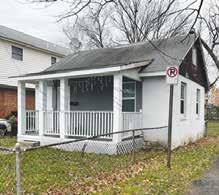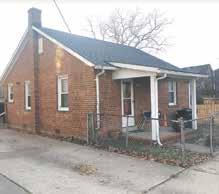
14 minute read
A Bit of History
“The idea of slavery being connected with the Black Colour, and Liberty with the White, where false Ideas are twisted into our Minds, it is with difficulty we get fairly disentangled,” New Jersey Quaker John Woolman [1720-1772] wrote. The time has come to articulate a historical truth, to acknowledge a woman black Alexandria homeowner Stanley Greene describes as “an abolitionist-minded angel.”
March is Women’s History Month: her name is Virginia Fitzhugh Wheat Thomas (1893-1987). A descendant of William Fitzhugh The Immigrant [1651-1701]; an indirect descendant of The Immigrant’s great grandson William Fitzhugh of Chatham [17411809]; his son William Henry Fitzhugh [1792-1830] of Ravensworth and Alexandria; granddaughter of Benoni [1823-1902] and Matilda Taliaferro Fitzhugh Wheat [1831-1885], daughter of Wheat & Suter real estate developer Harrie Fitzhugh [1866-1912] and Kate Duncan Houck Wheat [1869-1899].
Virginia was an inspired realtor whose post-World War interpretation of home ownership contributed to the construction of Alexandria’s Colored Rosemont. “The verdict of our voters… enjoins upon the people’s servants the duty of exposing and destroying the brood of kindred evils which are the wholesome progeny of paternalism,” President Grover Cleveland [D-NY] said in Virginia Fitzhugh Wheat’s birth year, in his 1893 Inaugural Address. “If in lifting burdens from the daily life of our people we reduce inordinate and unequal advantages too long ignored, this is but a necessary incident of our return to right and justice.”
On May 18, 1896—the same year the National Association of Colored Women formed—the U.S. Supreme Court ruled that “all railway companies carrying passengers in their coaches…shall provide equal but separate accommodations for the white and colored races.” [Plessy v. Ferguson 163U.S.537 (1896)] Soon after, the Reconstruction-era “Colored Republicans…served notice.” The lily-whites reply: rewrite Virginia’s constitution.
The Commonwealth’s new constitution became final in 1902, Benoni Wheat’s death year. “Discrimination…is precisely what we propose,” State Senator Carter Glass [D-VA] explained. “As has been said, we have accomplished our purpose strictly within the limitations of the Federal Constitution by legislating against the characteristics of the black race, not against the ‘race, color or previous condition’ of the people themselves.”
Benoni Wheat, “among Alexandria’s wealthiest and most enterprising merchants,” was a member of the preCivil War Whig Party [1840s]; the post-Civil War Temperance Party [1880s]. During the War he was captured by Confederate authorities, held hostage; ransomed and released. “There have lived but few, if any, men in Alexandria who were more universally respected and beloved by all classes than Benoni Wheat,” The Washington Post wrote.
The Niagara Movement, a black protest movement led by W.E.B. Du Bois distributed its Negro Declaration of Independence in 1905. The organizers demanded “full equality,” including “decent housing and neighborhoods...We plead for health, for an opportunity to live in decent houses and localities.” Virginia Fitzhugh Wheat [414 Duke Street] was then 12 years old; her mother Kate was dead, and Duke Street neighbor Kate Waller Barrett [408]—vice president and general superintendent of the
Florence Crittenton Homes—was advocating not only on behalf of the Homes [406], but also the National Women’s Council.
The National Women’s Council’s 1904 adopted resolutions: “equality of women with men in pulpit and church debate and on committee work; favoring married women being allowed to teach school; favoring the creation of schools for housekeeping; favoring allowing illegitimate children to take…a share of the father’s property; favoring juvenile courts and hygienic dress. In 1909 Barrett was also serving as the vice president of the women’s Equal Suffrage League of Virginia.
On March 12, 1912, Harrie Fitzhugh Wheat’s death year, the Virginia General Assembly passed “An Act to provide for designation by the cities and towns of segregation districts for residence of white and colored persons;…and for penalties for the violation of its terms.” Local segregation ordinances, if approved, designated districts as ‘white’ or ‘colored’ depending on whether 50 percent of the inhabitants were white or negro. Harrie, a selfdescribed Progressive was a member of Alexandria’s Citizens Progressive Association as of 1904.
Virginia’s wealth changed the day her father died. Said Harrie: “I hereby leave & bequeath all my property real & personal…for the sole use & benefit of my only child Virginia Fitzhugh Wheat [age 19]…The trusteeship… shall continue until [my daughter] reaches the age of 40 years [in 1933], when all…is turned over to [her].”
In 1915 The Washington Post listed Virginia among Alexandria’s social elite: attending parties with friends including A.H. Thomas 14 years her senior. The following year she was buying property; A.H. Thomas was thinking meaty thoughts, and Democrat Harry F. Byrd, Sr., took his seat in the Virginia State Senate.
“Byrd argued that a black electorate with decisive strength to sway elections constituted a much greater evil than ‘the continued and unchallenged government by a single political party,’” J. Douglas Smith recounted. Byrd also opposed women’s voting rights.
A.H. Thomas, a longtime employee of Armour & Co was a savvy sort. He thrice served as Armour’s branch manager: in Louisville, Kentucky; Washington and Alexandria. While in Louisville Augustus—in some way— became aware of the NAACP’s struggle to reverse a Kentucky court case known as Buchanan v. Warley.
Buchanan v. Warley [245U.S.60 (1917)] overturned Louisville’s 1914 racial zoning ordinance, an ordinance which prohibited whites selling and blacks buying homes in white-majority neighborhoods. The zoning ordinance was entitled “An ordinance to prevent conflict and ill-feeling between the white and colored races in the city of Louisville, and to preserve the public peace and promote the general welfare, by making reasonable provisions requiring, as far as practicable, the use of separate blocks, for residences, place of abode, and places of assembly by white and colored people respectively.”
“This ordinance prevents the occupancy of a lot in the city of Louisville by a person of color [newspaper editor and NAACP advocate William Warley] in a block where the greater number of residences are occupied by white persons,” U.S. Supreme Court Associate Justice William Day wrote. “This drastic measure is sought to be justified under the authority of the state in the exercise of the police power.” “But…the police power, broad as it is, cannot justify the passage of a law or ordinance which runs counter to the limitations of the federal Constitution’s 14th Amendment, a Reconstruction Amendment,” Day explained. “The right which the ordinance annulled was the civil right of a white man [real estate agent Charles Buchanan] to dispose of his property.” Buchanan’s affirmed “right to dispose of the property [by contract] to a constitutionally qualified purchaser.”
William Henry Fitzhugh, national Vice President of the American Colonization Society—a Society that operated from 1816 until 1964—“experimented in giving slave families small farms within Ravensworth to operate independently as tenants and buy their freedom.” To what extent did Fitzhugh’s economic model, Buchanan’s contractual model inspire Virginia Fitzhugh Wheat Thomas’ development of Colored Rosemont? Five generations, from Matilda forward carried the Fitzhugh name. Virginia Fitzhugh Wheat, 26, married Augustus Howell Thomas, age 40, on May 17, 1919. Together they had four children: Wheat, Augustus Jr. [born in Louisville], Kate, and Fitzhugh. In 1924 State Senator Harry F. Byrd was Chairman of the Virginia Democratic Party; the Virginia General Assembly passed the Racial Integrity Act [1924-1979] and Congress passed the “widely restrictive” Johnson-Reed Immigration Act. The Democratic Party convened in Chicago and the Thomas family contemplated a move: to 1515 Princess Street, Wheat & Suter’s 1893 Addition to Alexandria, Rosemont East. The Addition’s boundaries included Princess and Oronoco Streets, Earl and West Streets. West Street separated the races post-Plessy, up to and including the 1960s.
In 1937 President Franklin Roosevelt’s U.S. [public] Housing Act was law, as was his de facto Neighborhood Composition Rule. FDR [D-NY] traded racially restricted rental housing for Party-line passage of his New Deal legislation. To rent was to become dependent—on the Byrd machine, the Byrd Organization.
To the contrary Mrs. Thomas favored black home ownership. On June 19, 1939, Virginia Wheat Thomas bought “real estate…bounded by Wythe, Payne, West and Pendleton Streets” as part of her privately-funded, colored housing project. Her plan: a standardized minimum model with built-in potential for expansion, a fixed ratio of square footage to acreage. The Thomas’ Deeds of Bargain and Sale excluded racially restrictive covenants.
The abundance of Wheat & Suter’s pre-Plessy Alexandria property; Virginia’s many 1930s-1950s properties have long been underestimated, if analyzed at all. The same can be said for Virginia and the black buyers’ mortgage methods.
In June 1967, Alexandria’s City Council thought public housing “a bitter point.” Three years before black attorney Otto L. Tucker, Samuel W.’s brother, “challenged the city’s right to condemn land he owns [a house and 2 lots] for a public housing project, claiming that the site for the project was picked because its inhabitants [20 families] were Negroes.” The Alexandria Redevelopment Housing Authority declared lawyer Tucker’s racist assertions “irrelevant and immaterial to the proper issues involved....” Last year the Virginia Thomas/Gilbert Haggins house, 603 N. Alfred Street, was demolished; the 1949 property subdivided and redeveloped.
At what point are the complexities of black developmental history honestly told? “As gallant as is the effort of Virginia liberals,” John H. Young of the Negro Pittsburgh Courier concluded, “they still have a long way to go before they can shake off the shackles of machine politicians who hide their real fear—the loss of power.” The Commonwealth’s 1902 constitution did not change until 1971. “The subject of Civil Rights in Virginia must be faced openly and squarely by the people of Virginia,” Alexandria Democrat Armistead Boothe said in 1949. “[T]his social problem cannot be solved by failing to recognize it, to study it and to think about it. It will be our duty to the past, the present and the future to recognize and foster equality of opportunity. We must think and we must act.”
A.H. Thomas died in 1949. Still the Thomas’ vision lived on. Despite Byrd Democrats want to bury their truth.
Virginia Fitzhugh Wheat Thomas fostered equality of opportunity; helped blacks buy decent housing unencumbered as per the 1905 Negro Declaration of Independence, and author James Truslow Adams’1931 American Dream. Now it is the City’s turn to think about it, to recognize Virginia for the remarkable woman she was.




The history of public housing in the historically black Rosemont district of Alexandria lives on through existing housing stock. Pictured above, 711 N. West Street, 719 N. West Street, 1321 Wythe and 1312 Wythe Street are prime examples.
Sarah Becker started writing for The Economist while a graduate student in England. Similar publications followed. She joined the Crier in 1996 while serving on the Alexandria Convention and Visitors Association Board. Her interest in antiquities began as a World Bank hire, with Indonesia’s need to generate hard currency. Balinese history, i.e. tourism provided the means. The New York Times describes Becker’s book, Off Your Duffs & Up the Assets, as “a blueprint for thousands of nonprofit managers.” A former museum director, SLAM’s saving grace Sarah received Alexandria’s Salute to Women Award in 2007. Email: abitofhistory53@gmail.com
Erin Go Bragh
We here at the Old Town Crier love everything about St. Patrick’s Day including the history. We try to print this important information every year in the March issue and I am sure we have missed a few but we think it’s important that our readers know that it is more than just a day for a parade and swilling green beer! BTW, there will be no parade in Old Town Alexandria this year and no self-respecting Irish person drinks green beer! Just Sayin’!
A BIT OF ST. PATRICK’S DAY HISTORY
St. Patrick’s Day is celebrated on March 17, his religious feast day and the anniversary of his death in the fifth century. The Irish have observed this day as a religious holiday for over a thousand years.
On St. Patrick’s Day, which falls during the Christian season of Lent, Irish families would traditionally attend church in the morning and celebrate in the afternoon. Lenten prohibitions against the consumption of meat were waived and people would dance, drink, and feast—on the traditional meal of Irish bacon and cabbage.

THE FIRST PARADE
The first St. Patrick’s Day parade took place not in Ireland, but in the United States. Irish soldiers serving in the English military marched through New York City on March 17, 1762. Along with their music, the parade helped the soldiers to reconnect with their Irish roots, as well as fellow Irishmen serving in the English army.
Over the next thirty-five years, Irish patriotism among American immigrants flourished, prompting the rise of so-called “Irish Aid” societies, like the Friendly Sons of Saint Patrick and the Hibernian Society. Each group would hold annual parades featuring bagpipes (which actually first became popular in the Scottish and British armies) and drums.
In 1848, several New York Irish aid societies decided to unite their parades to form one New York City St. Patrick’s Day Parade. Today, that parade is the world ‘s oldest civilian parade and the largest in the United States, with over 150,000 participants.
Each year, nearly three million people line the one-and-a-half mile parade route to watch the procession, which takes more than five hours. Boston, Chicago, Philadelphia, and Savannah also celebrate the day with parades including between 10,000 to 20,000 participants.
NO IRISH NEED APPLY
Up until the mid-nineteenth century, most Irish immigrants in America were members of the Protestant middle class. When the Great Potato Famine hit Ireland in 1845, close to a million poor, uneducated, Catholic Irish began to pour into America to escape starvation. Despised for their religious beliefs and funny accents by the American Protestant majority, the immigrants had trouble finding even menial jobs. When Irish Americans in the country’s cities took to the streets on St. Patrick’s Day to celebrate their heritage, newspapers portrayed them in cartoons as drunk, violent monkeys.
However, the Irish soon began to realize that their great numbers endowed them with a political power that had yet to be exploited. They started to organize, and their voting block, known as the “green machine,” became an important swing vote for political hopefuls. Suddenly, annual St. Patrick’s Day parades became a show of strength for Irish Americans, as well as a must-attend event for a slew of political candidates. In 1948, President Truman attended New York City’s St. Patrick’s Day parade, a proud moment for the many Irish whose ancestors had to fight stereotypes and racial prejudice to find acceptance in America.
WEARING OF THE GREEN GOES GLOBAL
Today, St. Patrick’s Day is celebrated by people of all backgrounds in the United States, Canada, and Australia. Although North America is home to the largest productions, St. Patrick’s Day has been celebrated in other locations far from Ireland, including Japan, Singapore, and Russia.
In modern-day Ireland, St. Patrick’s Day has traditionally been a religious occasion. In fact, up until the 1970s, Irish laws mandated that pubs be closed on March 17. Beginning in 1995, however, the Irish government began a national campaign to use St. Patrick’s Day as an opportunity to drive tourism and showcase Ireland to the rest of the world. Last year, close to one million people took part in Ireland ‘s St. Patrick’s Festival in Dublin, a multi-day celebration featuring parades, concerts, outdoor theater productions, and fireworks shows.
O'DONOVAN| FROM PAGE 5
She approaches all that she does with passion. It is rare that you find someone who takes as much pride in what she does as Niamh does. She described O’Connell’s and all of the employees as her third child and puts herself on the line every day. Like she said, “I take pride in what I do and the buck stops with me. I want people to say ‘she does a good job and you know what you’re getting with Niamh’.” She is a pro in the hospitality business and is very active in the Old Town Community. She serves on the Boards of the Old Town Business Association, the Chamber of Commerce and Visit Alexandria. I can only imagine what a breath of fresh air she is to those entities.
When you ask Niamh about her boys she lights up as well. Conor and Brody are two very handsome and active teenagers who are lighting up rugby pitches around the area. Rugby has played a large part in her life starting with her father who played for years in Cork. I asked if she played rugby ‘back in the day’ and she just laughed and told me that if you count playing rugby in Phys Ed then the answer is yes!
She says she is a sucker for all animals with an affinity for horses and dogs. In addition to the boys, she wrangles three rescue pooches that have come to her from all over – Billy from Hawaii, Daisy from Puerto Rico and her standard poodle Lady Piper from North Carolina. I live in a one cat household and cannot fathom having two teenagers and three fur kids in my space on a regular basis!
If you would like to meet this dynamo in person, stop in at O’Connell’s and tell her you saw her profile in the Old Town Crier. You can pretty much catch her in the restaurant on any day. You won’t be disappointed that’s for sure.










